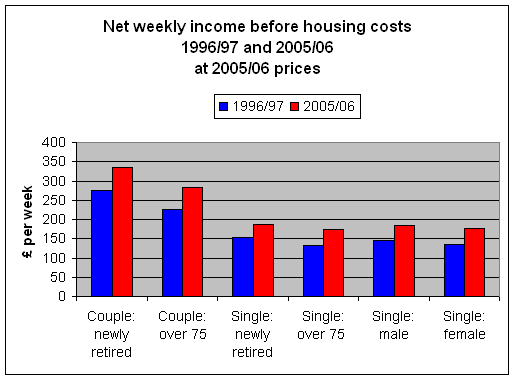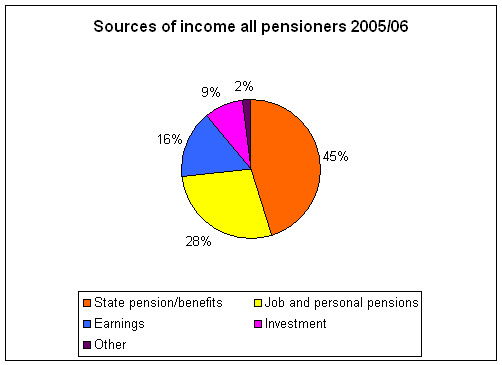Pensioners’ income survey
Retired people are wealthier than they have ever been. That is the main
conclusion of new official figures from the Office for National Statistics. They
show that over the last 26 years the real income of retired people has risen
every year by 2.5% to 3%. And it does not matter much which party is in power.
At the end of 17 years of Tory rule from 1979 to 1996/97 people over pension age
ended up 64% better off. In other words, their income after taking account of
price rises, was 64% higher in 1996/97 than it was in 1979. That works out at a
rise of 2.95% a year. And over the nine Labour years 1996/97 to 2005/06 (the
latest available) pensioners ended up 27% better off which is a very slightly
smaller annual rise of 2.69%.
Much of that growth is not due to the policies of either government. It is simply caused by the fact that newly retired people tend to be better off as wages and pensions linked to them rise. As each new generation become pensioners they boost the total income of the whole group. Individual pensioners who were retired in 1996/97 may be no better off now than they were then.

The graph shows that newly retired people are a lot better off than those who are already over 75. In 2005/06 the typical newly retired couple was £50 a week better off than a couple over 75. Among singles the age difference was less but still there - £188 compared to £175. Couples generally do much better than singles and single men are better off than single women. Across all ages, a typical retired couple gets by on £309. Single men have £184 a week while women manage on £177. In all categories after taking account of inflation, income in 2005/06 was much higher than in 1996/97. These typical incomes are what statisticians call ‘medians’ in other words half the population is above that level and half below. They are after tax but before housing costs are taken out and the 1996/97 incomes have been scaled up to take account of inflation.

In 2005/06 pensioners’ incomes came from five different sources. The biggest source was the state pension and other benefits – 45% of income. Then pensions from a job or saved up personally – 28%. A lot of pensioners still work, accounting for 16% of income on average. And investment income is 9% leaving income from various other sources at 2%.
Dormant accounts
Do you have money in a bank or building society account that you have
forgotten about? Many of us do and some estimates put the amount of forgotten
money in the hundreds of millions of pounds. At the moment the banks have this
money to use and earn interest on it – some have even counted it as their own
money in financial reports. So the Government has decided to put this money to
use. It is planning to make the banks and building societies hand over money in
dormant accounts to a fund which would use if for good causes.
An account will be considered dormant in future if there has been no activity on it for fifteen years. The money will then be transferred by the bank or building society to a new Reclaim Fund. It will keep aside a small amount to meet any claims from the rightful owners – who will be able to get their money back without a time limit – and pass the rest on to good causes. Before the scheme starts, perhaps in 2009, the banks and building societies will launch a 12 month appeal to get customers to reclaim dormant money. Meanwhile if you think there is money you have forgotten you can get a free claim form from the British Bankers Association 020 7216 8909 or the Building Societies Association 020 7437 0655 or check out their websites at www.bba.org.uk or www.bsa.org.uk. For money unclaimed from insurance companies and other institutions try the Unclaimed Assets Register on 0870 241 1713 or www.uar.co.uk – but it does charge a fee of £18 for a search.
Consumer credit and the Ombudsman
People who borrow money get two important new rights this month. First, they
will be able to take disputes to the Financial Ombudsman Service (FOS). Second,
they will be able to go to court to challenge credit deals they think are
‘unfair’. Until now the FOS could only look at complaints about loans or other
credit deals done with firms which are regulated directly by the Financial
Services Authority such as banks, insurers, and mortgage companies. But if you
bought a car on hire purchase from a garage or borrowed money from a shop to buy
a sofa or a kitchen you could not complain to the FOS. Now you can. In fact any
firm which has a consumer credit licence is covered including credit reference
agencies, pawnbrokers and even debt collectors pursuing a consumer debt.
You must take up the complaint with the company first and only if that does not produce the result you want can you go to the Ombudsman who can order compensation up to £100,000. The new complaints system will be free to consumers.
The other change allows borrowers to challenge any part of a credit agreement – including the interest rate – if it creates what is called an ‘unfair relationship’ between borrower and lender. The unfairness can cover the terms of the agreement, the way in which it is operated, or anything the lender does, or does not, do. Unfairness cases can also go to the Ombudsman or to the courts. All these new rights cover deals made on 6 April 2007 or later. New events on older credit deals may be covered in some cases.
FOS: 0845 080 1800 or www.financial-ombudsman.org.uk
Dogs in art
Once seen as Victorian kitsch, paintings of dogs are now becoming highly
collectible. Americans are the ones who want them – British owners are the ones
who have them. So now may be the time to check out the loft for that old dog
portrait left to you in a will. Bonhams pioneered sales of Dog Art in London in
1982 but a few years ago the sale moved to its New York auction rooms and
coincides with the Westminster Dog Show – the New York equivalent of Crufts.
Charles O’Brien, Director of Paintings at Bonhams in London, explains what
sells.
"What people want is pure breed paintings, a known breed with a named dog is very desirable. Or a domestic story with a dog such as puppies tipping over a bowl."
Bonhams sale last year set a new record for dog art when "New Forest Foxhounds" by John Emms fetched more than £400,000. This year’s top painting was "Setters" by Thomas Blinks which fetched £50,000 [see illus].
But Charles says you can pick up good work cheaper. "You could get a lovely Arthur Wardle sketch of the head of a hound for £1000."
To count as Dog Art the subject must be canine – if there are humans shown they must be in the background.
"The market is really for paintings from 1880s to 1940s. John Emms, Thomas Blinks, Maud Earl, Arthur Wardle are all desirable names. My ideal find would be work by one of those better artists, unrestored, in good condition, of a popular breed such as a spaniel."
You can send images to charles.obrien@bonhams.com for evaluation or call 020 7468 8360.

Fox Terrier by Arthur Wardle $26,888 (£14,150)

Setters by Thomas Blinks $94,250 (£49,600)
Hello HIPs
Since these paragraphs were written the Government has changed the plans for the introduction of HIPs. They will now begin on 1 August 2007 and then only for homes with four or more bedrooms. Some critics think they may now effectively be dead. Other changes will certainly be made.
If you put your home on the market in England and Wales from 1 June you will need to provide – and pay for – a new Home Information Pack. Estimates of the cost vary but around £400 seems to be the likely going rate. Although the seller pays, the pack is for the benefit of the buyer. It contains the searches on the property from the local council – the local land charges – which state what development plans and environmental matters might affect the property. The pack also contains an official document from the Land Registry showing who owns the property together with a map of the boundaries. Unregistered properties will need legal documents establishing ownership. In the past all these items were established by the buyer’s solicitor – but now the seller will have to pay for them.
The final part of the HIP is new. The energy performance certificate was originally to be part of a ‘Home Condition Report’ – a standard survey of the sort a buyer might commission. That report is no longer compulsory but the energy performance certificate is. It will rate the energy efficiency of the property from A (best) to G (worst) and a separate A-G rating will show its environmental impact as measured by emissions of carbon dioxide. The two ratings will usually be pretty much the same and the average home in the UK will be D or E on both. The report will suggest how to improve them by such things as draught-proofing, a new boiler, or cavity wall insulation.
The HIP will be a hefty document – the example on the Department for Communities and Local Government website runs to 64 pages – and, one way or another, the cost will find its way onto the price of every home sold from 1 June. Homes that are already on the market then will not need a HIP unless they are still unsold by 31 December 2007.
More at www.homeinformationpacks.gov.uk